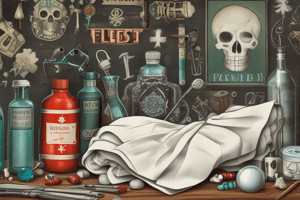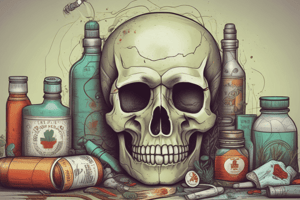Podcast
Questions and Answers
More than _______ of all poisonings are caused by ingestion.
More than _______ of all poisonings are caused by ingestion.
- 80% (correct)
- 50%
- 90%
- 65%
Which of the following statements regarding ammonia is false?
Which of the following statements regarding ammonia is false?
- It can severely burn the skin.
- It has an irritating odor.
- SCBA is not required when entering an area that contains ammonia. (correct)
- It is used as fertilizer.
Activated charcoal:
Activated charcoal:
- binds to poisons, preventing absorption in the digestive tract. (correct)
- is a finely ground powder mixed with milk to make it easier to swallow.
- is typically given in doses of 12.5 to 25 g for adults.
- is used when patients have ingested an acid or base.
The first step in treating a patient who has inhaled any poison gas is to:
The first step in treating a patient who has inhaled any poison gas is to:
Your patient has been poisoned by absorption. You should first:
Your patient has been poisoned by absorption. You should first:
After removing chemicals absorbed into clothing, responders treating patients poisoned by absorption should:
After removing chemicals absorbed into clothing, responders treating patients poisoned by absorption should:
When caring for a patient experiencing hallucinations, you should do all of the following EXCEPT:
When caring for a patient experiencing hallucinations, you should do all of the following EXCEPT:
What medicine is used to treat anaphylactic shock?
What medicine is used to treat anaphylactic shock?
If poison enters the body through the mouth and is absorbed by the digestive system, it is called:
If poison enters the body through the mouth and is absorbed by the digestive system, it is called:
If a poison enters the body through the mouth or nose and is absorbed by the mucous membranes lining the respiratory system, it is called:
If a poison enters the body through the mouth or nose and is absorbed by the mucous membranes lining the respiratory system, it is called:
When poison enters the body through a small opening in the skin, it may then be spread by the circulatory system. This is known as:
When poison enters the body through a small opening in the skin, it may then be spread by the circulatory system. This is known as:
If poison enters the body through intact skin, it may then be spread by the circulatory system. This is known as:
If poison enters the body through intact skin, it may then be spread by the circulatory system. This is known as:
Signs and symptoms of poisoning by ingestion may include all of the following EXCEPT:
Signs and symptoms of poisoning by ingestion may include all of the following EXCEPT:
The first step in treating a patient who has ingested a poison is to:
The first step in treating a patient who has ingested a poison is to:
Syrup of ipecac:
Syrup of ipecac:
Which of the following is not one of the four kinds of poisonous snakes found in the United States?
Which of the following is not one of the four kinds of poisonous snakes found in the United States?
Respiratory distress, cough, dizziness, headache, and confusion may be signs of poisoning by:
Respiratory distress, cough, dizziness, headache, and confusion may be signs of poisoning by:
If several members of one household are found at home, all with headache, nausea, disorientation, or unconsciousness, you should:
If several members of one household are found at home, all with headache, nausea, disorientation, or unconsciousness, you should:
Your first priority when arriving at the scene of a call involving a suspected nerve agent should be:
Your first priority when arriving at the scene of a call involving a suspected nerve agent should be:
Which of the following is not a sign of anaphylactic shock?
Which of the following is not a sign of anaphylactic shock?
Which of the following statements regarding abuse of inhalants is true?
Which of the following statements regarding abuse of inhalants is true?
Which of the following statements regarding patients who have absorbed poisons is false?
Which of the following statements regarding patients who have absorbed poisons is false?
Delirium tremens (DTs):
Delirium tremens (DTs):
Drugs that stimulate the nervous system:
Drugs that stimulate the nervous system:
An EMR's responsibility in a call involving drug overdose includes:
An EMR's responsibility in a call involving drug overdose includes:
Flashcards
Primary cause of poisonings?
Primary cause of poisonings?
Most poisonings occur when someone swallows a substance.
Ammonia safety?
Ammonia safety?
Protect yourself with SCBA in an ammonia environment.
What does activated charcoal do?
What does activated charcoal do?
It binds with poison and prevents absorption.
Inhaled poison initial action?
Inhaled poison initial action?
Signup and view all the flashcards
Poison absorption first step?
Poison absorption first step?
Signup and view all the flashcards
Treating absorbed poisons?
Treating absorbed poisons?
Signup and view all the flashcards
Hallucination care?
Hallucination care?
Signup and view all the flashcards
Anaphylactic shock treatment?
Anaphylactic shock treatment?
Signup and view all the flashcards
Poisoning via ingestion?
Poisoning via ingestion?
Signup and view all the flashcards
Poisoning via inhalation?
Poisoning via inhalation?
Signup and view all the flashcards
Poisoning via injection?
Poisoning via injection?
Signup and view all the flashcards
Poisoning via absorption?
Poisoning via absorption?
Signup and view all the flashcards
Ingestion poisoning signs?
Ingestion poisoning signs?
Signup and view all the flashcards
Treating ingested poison?
Treating ingested poison?
Signup and view all the flashcards
Syrup of ipecac?
Syrup of ipecac?
Signup and view all the flashcards
Not poisonous US snake?
Not poisonous US snake?
Signup and view all the flashcards
Inhalation poisoning signs?
Inhalation poisoning signs?
Signup and view all the flashcards
Multiple people sick: suspect?
Multiple people sick: suspect?
Signup and view all the flashcards
Nerve agent scene: priority?
Nerve agent scene: priority?
Signup and view all the flashcards
Not a sign of anaphylaxis?
Not a sign of anaphylaxis?
Signup and view all the flashcards
Inhalant abuse risk?
Inhalant abuse risk?
Signup and view all the flashcards
Absorbed poisons?
Absorbed poisons?
Signup and view all the flashcards
Delirium tremens (DTs)?
Delirium tremens (DTs)?
Signup and view all the flashcards
Stimulant drugs?
Stimulant drugs?
Signup and view all the flashcards
Drug overdose responsibility?
Drug overdose responsibility?
Signup and view all the flashcards
Signs and symptoms of poisoning by ingestion?
Signs and symptoms of poisoning by ingestion?
Signup and view all the flashcards
Signs and symptoms of poisoning by inhalation?
Signs and symptoms of poisoning by inhalation?
Signup and view all the flashcards
Signs and symptoms of anaphylactic shock?
Signs and symptoms of anaphylactic shock?
Signup and view all the flashcards
Signs and symptoms of poisoning by absorption?
Signs and symptoms of poisoning by absorption?
Signup and view all the flashcards
Inhalant abuse dangers?
Inhalant abuse dangers?
Signup and view all the flashcards
Study Notes
- More than 80% of all poisonings are caused by ingestion.
- SCBA is required when entering an area that contains ammonia
- Activated charcoal binds to poisons, preventing absorption in the digestive tract.
- The first step in treating a patient who has inhaled any poison gas is to remove the patient from the source of the gas.
- When a patient has been poisoned by absorption, first wash the affected area.
- After removing chemicals absorbed into clothing, responders treating patients poisoned by absorption should wash the patient thoroughly with a hose or a showe
- When caring for a hallucinating patient, provide auditory and visual stimulation
- Epinephrine is medicine used to treat anaphylactic shock
- If poison enters the body through the mouth and is absorbed by the digestive system, it is called ingestion.
- If a poison enters the body through the mouth or nose and is absorbed by the mucous membranes lining the respiratory system, it is called inhalation.
- When poison enters the body through a small opening in the skin, it may then be spread by the circulatory system. This is known as injection.
- If poison enters the body through intact skin, it may then be spread by the circulatory system. This is known as absorption.
- Chest tightness is not a sign or symptom of poisoning by ingestion.
- The first step in treating a patient who has ingested a poison is to attempt to identify the poison
- Syrup of ipecac is no longer recommended to treat poisoning.
- A garter snake is not one of the four kinds of poisonous snakes found in the United States
- Respiratory distress, cough, dizziness, headache, and confusion may be signs of poisoning by inhalation.
- If several members of one household are found at home, all with headache, nausea, disorientation, or unconsciousness, suspect carbon monoxide poisoning.
- Your first priority when arriving at the scene of a call involving a suspected nerve agent should be keeping yourself and others around you from becoming contaminated.
- Increased blood pressure is not a sign of anaphylactic shock.
- Inhalant abuse can lead to unconsciousness and death
- A false statement regarding patients who have absorbed poisons is that the affected area should be immediately washed with water.
- Delirium tremens(DTs) are a serious and possibly fatal medical emergency
- Drugs that stimulate the nervous system include amphetamines and cocaine
- An EMR's responsibility in a call involving drug overdose includes arranging for prompt transport to a medical facility.
Studying That Suits You
Use AI to generate personalized quizzes and flashcards to suit your learning preferences.
Related Documents
Description
Learn about common poisoning routes, including ingestion, inhalation, and absorption. Understand treatment protocols such as using SCBA in ammonia-filled environments and washing affected areas after absorption. Recognize the importance of epinephrine for anaphylactic shock.




